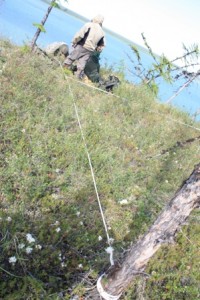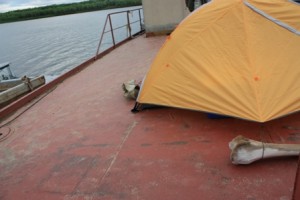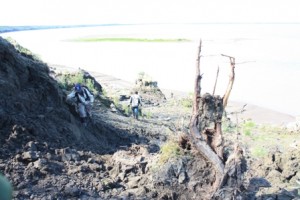Normally fifteen people sleep on the barge while others sleep at the station itself on the hill above the river. In order to nearly double our occupancy empty bunks that were previously used for storage were cleared, the second floor of the barge (which is more hidey-hole than floor) was aired out, and a tent was set up on the deck. Even then there wasn’t quite enough room so a few people slept on the boat that was towing us and one person even slept on the floor of the kitchen area.
The barge casted off after dinner on the 11th, around 10:30 PM. By 1PM the next day the hills began to sparkle with exposed permafrost. Everyone was excited for our fieldtrip. New places to sample for some of us, new adventures for all of us.
Before debarking we were all given a safety lecture. Elsewhere injuries could happen from being careless. Here injuries could happen because it is dangerous (although being careless helps a lot). We were instructed on the best ways to move across the mud, and what to avoid because it could cause a slide. All of it was pretty simple- don’t walk on the more watery mud, you could lose your boots or get stuck. Don’t walk on or under an overhang in case it falls. The only person to lose their boots for a while was one of the people who work at the station who had been to Duvannyi Yar before. We were jokingly asked not to tell next year’s participants.
While there, Peter and I were looking at how shrub cover changes as you move from the disturbed cliffs themselves, then to the top of the hill and down to the lake on the other side. Valentin, a scientist who joined us from the Permafrost Institute in Yakutsk, rapelled down the cliffs a bit to gather samples down the length of the cliff to look at changes trapped in the sediments over time. Others were collecting water or shrub samples.

He wasn’t actually hanging off a cliff. He was standing on the piles of sediment working his way down like stairs. The rope was there just in case those stairs gave way.
Others who didn’t have projects involving Duvannyi Yar explored the area their own way. Running around and digging through the muddy banks looking for bones trapped since the ice age 20-30 thousand years ago.
Sergei Zimov who has been doing science in Cherskiy and the surrounding area for over 30 years quizzed a few of us on the best way to estimate the amount of erosion taking place in the region. While a few theories were developed, they weren’t the best way. I bet you couldn’t have guessed it either: If the density of mammoth skeletons in the permafrost is known (which it is) then all you need to know is the amount of mammoth ivory sold year to year in the region! As people find new mammoths they sell it. More mammoths, more erosion; less mammoths less erosion. Mammoth ivory records stretch back 200 years so there is a very accurate picture of overall soil loss throughout the Kolyma watershed.
Duvannyi Yar was a much needed respite from the high pace kept at the Northeast Science Station. Everyone understands that with such a limited amount of time here we have to take every advantage to get our work done but the pace can’t be kept forever. Two nights and a full day of low key was definitely needed. Now we are back and ready to bust out some serious data.
EDIT: When I first posted this I said Duvannyi Yar meant ‘Robber Cliff’ in Russian. It turns out that is not quite right. Duvannyi is based on the Russian word duvannyich which is when thieves split up their merchandise. So Duvannyi Yar are cliffs where thieves split their haul.






Comments(2)-
-
Lisa Parkinson says
July 13, 2012 at 3:47 amFascinating! What an amazing experience!
Joanne Heslop says
July 13, 2012 at 7:27 pmI love the mammoth bones for the tent! I hope some of you guys slept on the barge’s porch roof too, that was one of the best experiences 🙂